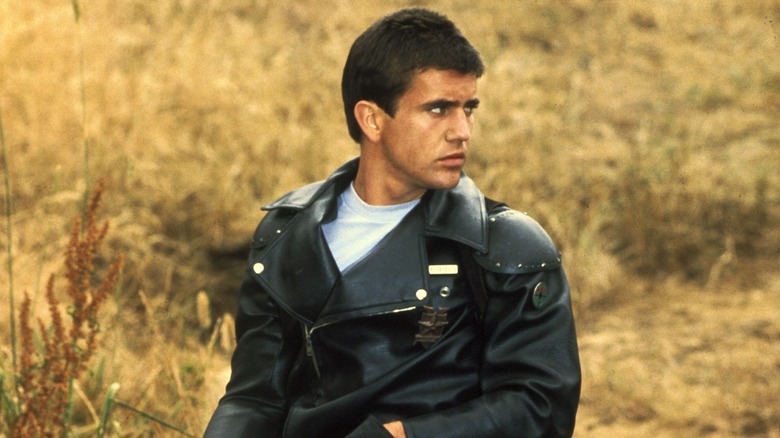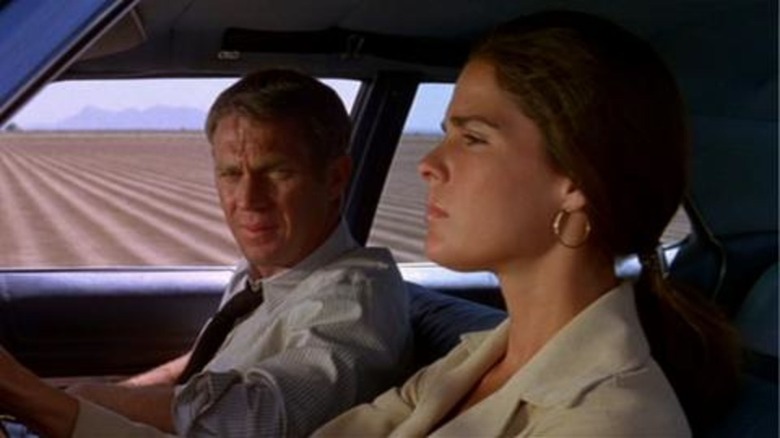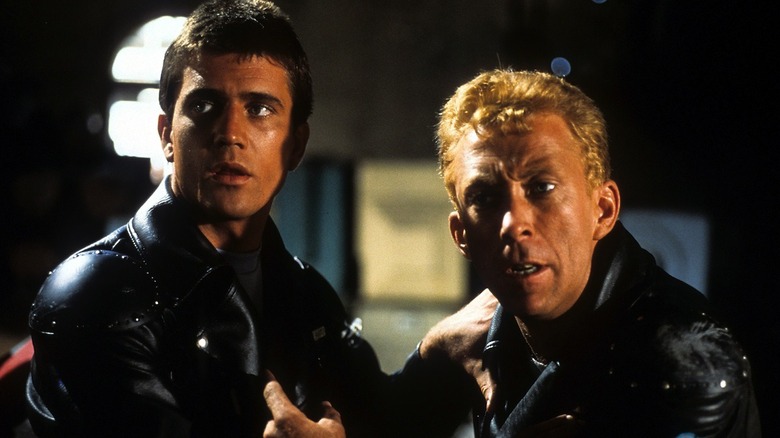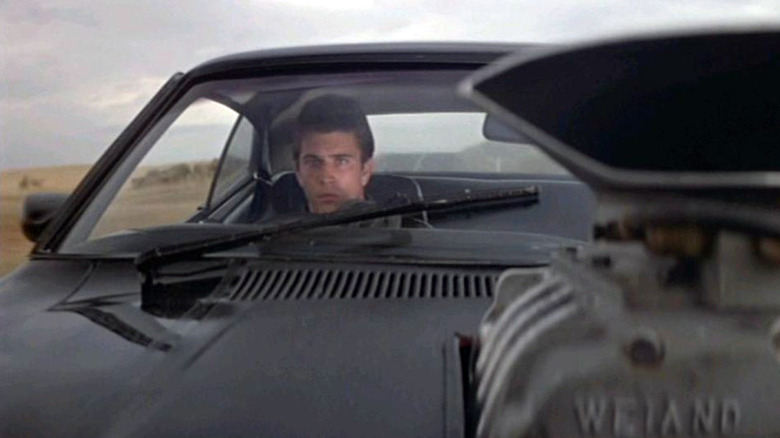Mad Max Owes Its Look To A Low Budget, Steve McQueen, And Sam Peckinpah
Nothing can look pretty gorgeous in widescreen, and there was quite a lot of it in the Australian New Wave of the '70s. The daunting expanse of the Outback provided the canvas for several classic films of the period, such as two masterpieces that were roughly analogous to the folk horror genre emerging in Britain around the same time: Nicholas Roeg's "Walkabout" and Ted Kotcheff's controversial "Wake in Fright." In these movies, the stark setting created a dislocating sense that white settlers don't belong in such a harsh and humbling environment, adding to their aura of unease.
Most of the notable films of the Aussie New Wave were set in the past or present but, as the '80s beckoned, the biggest hit of the bunch looked to the future in George Miller's "Mad Max." Unlike "Walkabout" and "Wake in Fright," which were both shot in the heart of the Outback, its locations were relatively close to civilization, not far from Melbourne on the south coast. However, it still looks like a suitably desolate area for a dystopian future, which Miller would revisit in increasingly elaborate stages over the franchise, culminating in the epic visuals and non-stop motor mayhem of "Mad Max: Fury Road."
Compared to the water-hoarding warlords, apocalyptic storms, and exotically fortified vehicles of that outrageous fourth installment, "Mad Max" has more in common with car chase movies of the '70s like "Vanishing Point," "The Driver," and Sam Peckinpah's heist thriller "The Getaway." The latter inadvertently had a major impact on the way Miller's box office hit looked on screen.
From a Hollywood hit to an Australian box office smash
After a string of memorable movies in the '60s and receiving his first and only Oscar nomination for his performance in "The Sand Pebbles," Steve McQueen's career had a bit of a wobble at the end of the decade. He had walked away from a role in "Butch Cassidy and the Sundance Kid" because he wanted top billing and the same amount of lines as Paul Newman, going on to star in the forgotten comedy "The Reivers" while George Roy Hill's affectionate buddy western became a smash hit.
His passion project "Le Mans" was a box office failure and "Junior Bonner," on which he worked with maverick director Sam Peckinpah, also flopped. He needed a hit to restore his fortunes. Along came "The Getaway," also helmed by Peckinpah, which paired the faltering star with Ali McGraw. As its name suggests, the movie features some car chases, but nothing compared to the celebrated San Francisco set piece in "Bullitt" a few years earlier.
"The Getaway" was a no-nonsense directorial effort from Peckinpah, falling some way short of his true classics like "The Wild Bunch" and "Bring Me the Head of Alfredo Garcia." While reviews were mixed, the film was a financial success and re-established McQueen as a major box office draw, setting the table for his high-profile p***ing contest with Paul Newman during the production of "The Towering Inferno." Peckinpah went on to make several more movies in his typically uncompromising style before passing away in 1984. As for the lenses used by cinematographer Lucien Ballard to shoot the film, they found their way across the Pacific Ocean to Australia and played a role in how George Miller's directorial debut would look.
It took a long while for George Miller to raise the money for Mad Max
Befitting a director who made his name with a full-throttle thriller, George Miller's career is full of surprising left turns. After the "Mad Max" Trilogy, he went mainstream with "The Witches of Eastwick" and the solid disease-of-the-week drama "Lorenzo's Oil," before moving on to make some talking pig pictures ("Babe," which he co-wrote, and its sequel, which he directed) and dancing penguin animations ("Happy Feet" 1 & 2). He then made another screeching left turn back onto "Fury Road."
The start of his career was also unconventional. He worked as a doctor in a Brisbane hospital before meeting Byron Kennedy, his "Mad Max" collaborator, on a summer film course. They made a short movie together, "Violence in the Cinema, Part 1," which did well on the festival circuit and won a few awards, but they wouldn't get their chance to make a full feature until several years later.
In the meantime, the 1973 Oil Crisis revealed an ugly side to motorists as the fuel shortage hit Australian gas stations. Co-screenwriter James McCauseland remembered (via News.com):
"A couple of oil strikes that hit many pumps revealed the ferocity with which Australians would defend their right to fill a tank. Long queues formed at the stations with petrol – and anyone who tried to sneak ahead in the queue met raw violence... George and I wrote the script based on the thesis that people would do almost anything to keep vehicles moving and the assumption that nations would not consider the huge costs of providing infrastructure for alternative energy until it was too late."
Eventually, Miller and Kennedy scraped together the $350,000 (roughly $1.4 million today) they needed to make the film. It was enough to realize the project, but it meant cutting a lot of corners to keep the costs down.
Sam Peckinpah's old lenses made Mad Max more cinematic
In an interview with the National Film and Sound Archive of Australia, George Miller recalls how he and Byron Kennedy did everything they could to keep within their modest budget. This necessary thriftiness extended to the lenses used to shoot the film:
"Everything was done in a very innovative, resourceful way. It meant that the lenses we had were lenses – Sam Peckinpah had shot a movie, 'The Getaway,' one of the last movies Steve McQueen had made, and he used these Todd-AO lenses which were so damaged by the car action that... they were dumped down in Australia."
Miller lucked out by obtaining those lenses. Produced by the Todd-AO company in the United States, they were high-quality equipment intended to compete with Panavision in the 35mm market. Other movies shot with Todd-AO 35 include "Conan the Barbarian" and David Lynch's "Dune," and, despite costing a fraction of the budget of those films, "Mad Max" looks just as crisp.
A lot of "Mad Max" is watching vehicles driving very fast in the middle of nowhere, and there's something about that classic 35mm letterbox format that really boosts the cinematic quality of the action. Because it looks so sharp, it also goes a long way toward disguising the film's budgetary restrictions. Once he had his footage, Miller had to cut the movie himself because they couldn't afford an editor, and there are flashes of the bold invention that would evolve into the outlandish visual feast of "Mad Max: Fury Road." With his second-hand lenses and DIY attitude, Miller proved that having little money can be a blessing; the hard work paid off as "Mad Max" racked up almost $100 million worldwide, made Mel Gibson a star, and started a successful franchise. Not bad for a movie shot with Sam Peckinpah's cast-offs.



